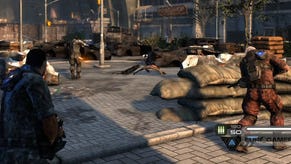Inversion
Gears of lawsuit.
Blue "conduits" allow you to move between planes and move things between them - aim a grenade across the threshold and it will change direction in midair as gravity changes around it. Objects shift too, like cars and bodies. Some areas will go back to normal after a while, but others are left permanently in their new state.
Extensive use of Havok physics (welcome back!) is the key to the gravity effects, according to the developers, but Havok is arguably most impressive when it's used in more familiar but unusually spectacular ways.
This may be a Gears of War clone in combat terms, but despite Epic Games' mastery of Unreal Engine 3, Saber appears to be no slouch either, coaxing screen-filling, physics-driven building collapses and other amazing visual feats from the tech driving Inversion.
Although the physics implementation does have limits, a lot more of the world is rigged to give way than you would expect. There are simple things, like a bridge across an alleyway with aliens on it that falls apart when you blow the support struts. You can snipe an enemy on a distant rooftop and watch him fall 50 stories, dismembering and destroying scaffolding in the process.
If you really dislike scaffolding you can also blow explosive barrels at the foot of it, collapsing it on more pesky alien invaders. Meanwhile, we're usually down on turret gun sections, but they get a pass when you can cut the legs off a warehouse and watch it fall and visibly disintegrate as enemies scatter in its path. Saber's keen to emphasise that these physics reactions are not scripted, either, so what you see will differ to whatever we do.
You will pick up new gravity device powers as the game goes on - like the ability to pick up larger objects like cars and use them as movable shields. The caveat is that cars often explode when people shoot them repeatedly.
You'll have a pool of gravity energy to draw upon used by gravity weapons like the shock effect grenade, which releases a pulse that destroys everything in its radius. Energy will refill over time, but there will be other means of refilling it faster.
When it's not doing gravity-related things, Inversion continues to resemble its inspiration - albeit with more environmental destruction. A cramped shootout in an apartment building sees enemies turning over fridges to hide behind, while your shotgun punctures gaping holes in the plasterboard.
There are a few varieties of enemy evident too, including a heavily-armoured guy who has Shogun-style plating on his front but very little protection on his back. Enemies will have "full gibbing", the developer explains. We got that.
Inversion should have split-screen and online co-operative play when it launches, although other multiplayer options will be revealed later. That's not too surprising as Saber says the game is due out next year.
But what does Saber CEO Matthew Karch have to say about the Gears comparisons? Isn't he worried people will be dismissive of Inversion when it looks so similar?
"A little bit," he tells Eurogamer. "To be perfectly honest, we used Gears as an inspiration. We're not going to shy away from it - it's a good game, and why reinvent the wheel? I think what we're bringing new is really on the physics front.
"Yeah, I'm sure some people are going to say that, and that's fine. As long as we can match what Gears is doing... We love that game, so why not?"
Inversion is due out for PS3 and Xbox 360 in 2011.







.png?width=291&height=164&fit=crop&quality=80&format=jpg&auto=webp)



